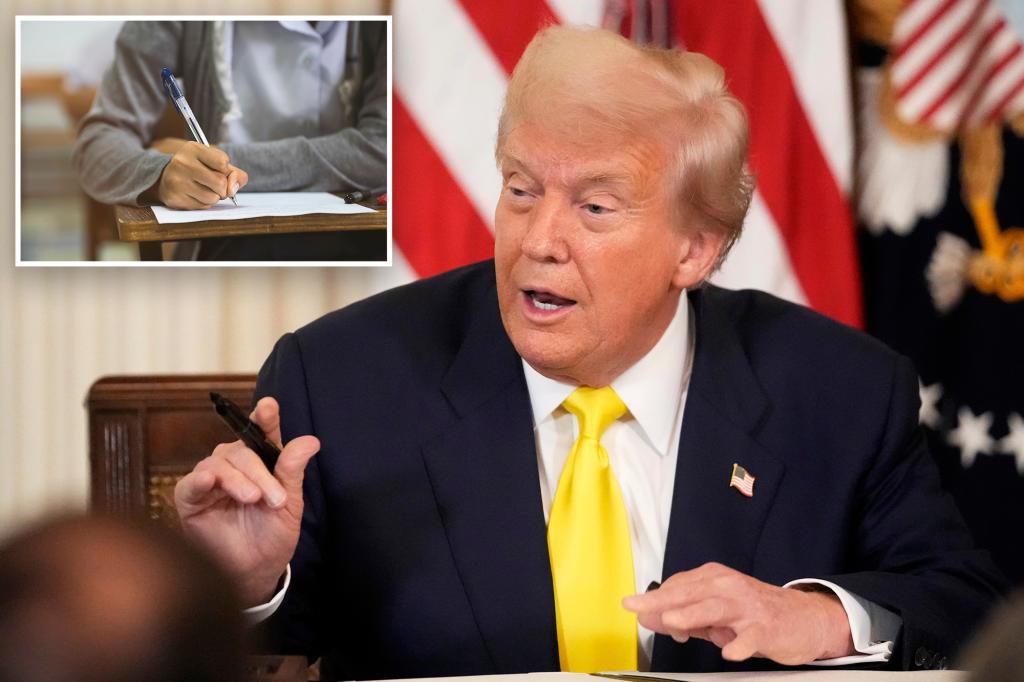Colleges will be required to submit data to prove they do not consider race in admissions under a new policy ordered Thursday by President Donald Trump.
In 2023, the Supreme Court ruled against the use of affirmative action in admissions but said colleges may still consider how race has shaped students’ lives if applicants share that information in their admissions essays.
Trump is accusing colleges of using personal statements and other proxies to consider race, which conservatives view as illegal discrimination.
The role of race in admissions has featured in the Trump administration’s battle against some of the nation’s most elite colleges — viewed by Republicans as liberal hotbeds.
For example, the new policy is similar to parts of recent settlement agreements the government negotiated with Brown University and Columbia University, restoring their federal research money.
The universities agreed to give the government data on the race, grade point average and standardized test scores of applicants, admitted students and enrolled students.
The schools also agreed to be audited by the government and to release admissions statistics to the public.
Trump says colleges may be skirting SCOTUS ruling
Conservatives have argued that despite the Supreme Court ruling, colleges have continued to consider race.
“The persistent lack of available data — paired with the rampant use of ‘diversity statements’ and other overt and hidden racial proxies — continues to raise concerns about whether race is actually used in admissions decisions in practice,” says the memorandum signed by Trump.
The memo directs Education Secretary Linda McMahon to require colleges to report more data “to provide adequate transparency into admissions.”
The National Center for Education Statistics will collect new data, including the race and sex of colleges’ applicants, admitted students and enrolled students, the Education Department said in a statement.
If colleges fail to submit timely, complete and accurate data, McMahon can take action under Title IV of the Higher Education Act of 1965, which outlines requirements for colleges receiving federal financial aid for students, according to the memo.
It is unclear what practical impact the executive order will have on colleges.
Current understanding of federal law prohibits them from collecting information on race as part of admissions, said Jon Fansmith, senior vice president of government relations at the American Council on Education, an association of college presidents.
“Ultimately, will it mean anything? Probably not,” Fansmith said.
“But it does continue this rhetoric from the administration that some students are being preferenced in the admission process at the expense of other students.”
Because of the Supreme Court ruling, colleges have been barred from asking the race of students who are applying, Fansmith said.
Once students enroll, the schools can ask about race, but students must be told they have a right not to answer.
In this political climate, many students won’t report their race, Fansmith said.
So when schools release data on student demographics, the figures often give only a partial picture of the campus makeup.
Diversity changed at some colleges — but not all
The first year of admissions data after the Supreme Court ruling showed no clear pattern in how colleges’ diversity changed.
Results varied dramatically from one campus to the next.
Some schools, such as the Massachusetts Institute of Technology and Amherst College, saw steep drops in the percentage of Black students in their incoming classes.
But at other elite, selective schools such as Yale, Princeton and the University of Virginia, the changes were less than a percentage point year to year.
Some colleges have added more essays or personal statements to their admissions process to get a better picture of an applicant’s background, a strategy the Supreme Court invited in its ruling.
“Nothing prohibits universities from considering an applicant’s discussion of how race affected the applicant’s life, so long as that discussion is concretely tied to a quality of character or unique ability that the particular applicant can contribute to the university,” Chief Justice John Roberts wrote in 2023 for the court’s conservative majority.
As an alternative to affirmative action, colleges for years have tried a range of strategies to achieve the diversity they say is essential to their campuses.
Many have given greater preference to low-income families.
Others started admitting top students from every community in their state.
Prior to the ruling, nine states had banned affirmative action, starting with California in 1996.
The University of California saw enrollment change after the statewide ban in 1996.
Within two years, Black and Hispanic enrollments fell by half at the system’s two most selective campuses — Berkeley and UCLA.
The system would go on to spend more than $500 million on programs aimed at low-income and first-generation college students.
The 10-campus University of California system also started a program that promises admission to the top 9% of students in each high school across the state, an attempt to reach strong students from all backgrounds.
A similar promise in Texas has been credited for expanding racial diversity, and opponents of affirmative action cite it as a successful model.
In California, the promise drew students from a wider geographic area but did little to expand racial diversity, the system said in a brief to the Supreme Court.
It had almost no impact at Berkeley and UCLA, where students compete against tens of thousands of other applicants.
Today at UCLA and Berkeley, Hispanic students make up 20% of undergraduates, higher than in 1996 but lower than their 53% share among California’s high school graduates.
Black students, meanwhile, have a smaller presence than they did in 1996, accounting for 4% of undergraduates at Berkeley.
After Michigan voters rejected affirmative action in 2006, the University of Michigan shifted attention to low-income students.
The school sent graduates to work as counselors in low-income high schools and started offering college prep in Detroit and Grand Rapids.
It offered full scholarships for low-income Michigan residents and, more recently, started accepting fewer early admission applications, which are more likely to come from white students.
Despite the University of Michigan’s efforts, the share of Black and Hispanic undergraduates hasn’t fully rebounded from a falloff after 2006.
And while Hispanic enrollments have been increasing, Black enrollments continued to slide, going from 8% of undergraduates in 2006 to 4% in 2025.
Read the full article here







